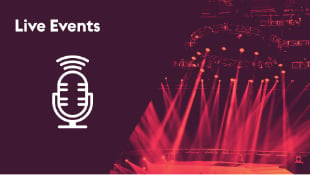How to Take Your Live Events Business to the Next Level
Three seasoned live event professionals came together for a conversation with AV expert Tom Stimson to share how they are adapting their businesses to the current environment, what’s next for their organizations, and how they see the live events industry playing out in the long run.
Our panelists were Anthony Vade, CED, FMAV; Heidi Brumbach, Technisch Creative; and Sean Mason, Immersive. Watch the full discussion: How to Take Your Live Events Business to the Next Level.
Here’s what they had to say.
What Event Planners are Currently Thinking
As a result of the conversations over the last few months, Anthony shared his observations of event planner buyer motives and summarized these into four different personas, to help the audience adapt their services based on their client’s needs:
- The Futurist: The planners who have already been playing in digital and now see this as a chance to go all in and make great digital experiences.
- The Experimentalist: The planners who have done a little bit of digital and are willing to try new things and are less risk averse.
- The Conversationalists: The planners who don’t care about digital or virtual but know that they need their event to happen. For them, this year is just a ‘make it happen year.’
- The Dazed to Confused: The planners who have watched every demo and webinar for 4 or 5 weeks and now suffer from Zoom fatigue. They are overwhelmed and don’t know which solutions to plug into.
Finding New Ways to Stay Relevant and Build Revenue Streams
Heidi’s company specializes in the live event meeting space. To begin with she was very apprehensive to jump onto the live streaming bandwagon, but she saw that there was a gap and a need to improve the quality: “As long as we can create something to contribute to who we are at our core and it complements our business in the long run, I am OK with it.” She added, “We have been able to dedicate some time to build out studio space in our office, make new connections we can partner with, build up a portfolio, and figure out which offerings will be most valuable in the long run. It’s another opportunity for us, and I think the pivot is going to work.”
“It’s another opportunity for us and I think the pivot is going to work.”
Sean’s team members are looking at live stream models but they are also brainstorming for when reopening begins in the near future, “We are looking at how we can create outdoor, socially distanced experiences first and then move to indoor socially distanced experiences while incorporating large scale projection mapping.”
Sean spoke about his thoughts on how we are going to consume experiential events going forward, “The large wow factor about larger installations is the in-person grandiose nature of the experience. We are looking at creating more socially distanced throughput for these experiential events such as pop up drive-in movie theatres where bands, corporates, etc., have an outdoor arena for an experiential show.”
He also emphasized the importance of investing in production values of a live stream and treating it like a TV show, “We are looking at building stages and filming it as if it is a general session and putting some budget behind it to make a large LED wall backdrop or a projection mapped stage set and do camera shifts and on location shoots.”
Anthony put an interesting spin on the revenue opportunity, “The expectation on all stakeholders coming out of this will be higher. Over the next year or two as we work our way out of this and get back more into live events, event planners are going to have access to so much data and analytics to prove whether or not the event was successful. People will be saying, ‘Tell me the measurements that said it was worthwhile.’ If we are not building that into our design principles from the start, then we are going to be in a tricky place. The good news is that if the event planners are coming to us asking for deep understanding of analytics, then we need to design that and if people expect that outcome, they should be paying for that outcome through the process. This means we must bring design principles as a fee for service offering with every company providing impactful experiences.”
“We must bring design principles as a fee for service offering with every company providing impactful experiences.”
Is the Future Hybrid?
“An event, is an event, is an event. It doesn’t matter if it is virtual, live, or hybrid. Really we are there to change the behaviors of stakeholders.”
It’s almost a given that the future will be hybrid. According to Heidi, learning how to produce ‘hybrid’ is really important right now as the human brain can only absorb so much by looking at a screen.
Anthony believes that in North America we are going to see a hub and spoke setup where there will be smaller groups all interacting through a hybrid model with regional connections, which is an opportunity for AV companies.
However, Anthony’s advice was, “An event, is an event. It doesn’t matter if it is virtual, live, or hybrid, really, we are there to change behaviors of stakeholders. The delivery mechanism is important, but we need to get over that and get back to the real purpose and reason for the event. My dream is that the digital world enhances the live experience. It can perform a time warping where the content and information sharing can be extended over a longer period and people can access digital information after the event. This is a great opportunity for live event professionals to get higher value from their live activation. They will have to think about design parameters and how they differ from the live attention span, which is 50% in the virtual space, and how you design both so that you are not alienating the audiences in either space.”
Sean observes that people are considering a lot of ideas but have not yet made the leap into hybrid events because of not knowing the rules and stipulations yet, “We are in the design phase for several projects right now. Historically we have looked toward corporate presentations that are niche, now we are expanding more into experiences for larger groups of people, appealing to the masses. We are widening our scope as to what is an event, what are people going to feel safe being involved in, and cater our designs and concepts to that model.”
Tom asked the question, when we move to hybrid, how are we going to get a balance between virtual and local events?
“There will be platforms that live outside the parameters of an event.”
Heidi’s view also is that people will get used to virtual platforms and sharing online. “I think there will be platforms that live outside the parameters of an event. There will be some sort of chat room or virtual world where people can connect before the event and after the event. We are looking at opportunities in that arena that can create value.”
Sean added, “All events should be virtual in some shape or form because there is a portion of your audience that is never going to be able to attend in person. This has always been the case; it has just come more into the limelight now.”
Sean also mentioned that events don't necessarily need to be live streams; it could be post-edits, documentation or archive footage that is put together in a meaningful way, with a meaningful message to keep people engaged.”
The panel gave some closing tips and advice for the audience:
Heidi: “Don’t depart from who you are and stick to your core values.”
Anthony: “Human being first, platform second.”
Sean: “Maintain the sense of hope and inspiration behind what you do.”
Tom: “Our job is to meet our customers and employees where they are and work from there.”
Watch Next: Events Reinvented: An Interview with Elle Chan, Founder and Co-CEO of Trademark Event Productions
The live events industry has been forced to take a giant collective pause and that's a huge test for us all. Elle Chan, Founder and Co-CEO of Trademark Event Productions, discusses the importance of collaborative working, creative thinking, and listening to your audience to achieve new experiences for our clients.





.png?sfvrsn=519c2f3c_1)